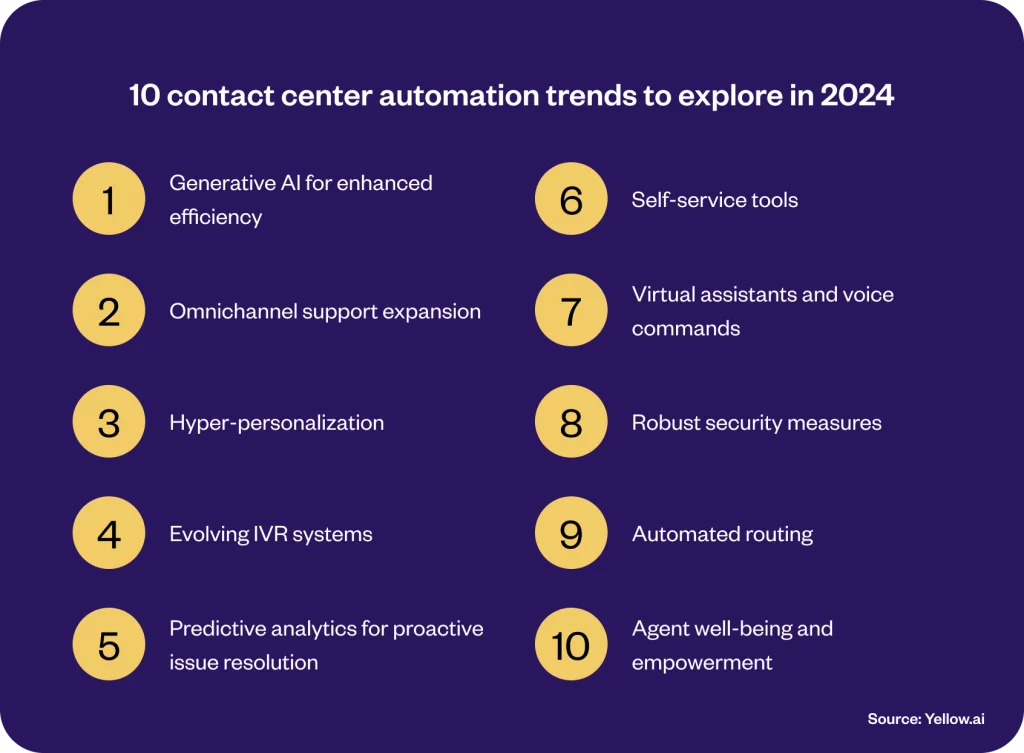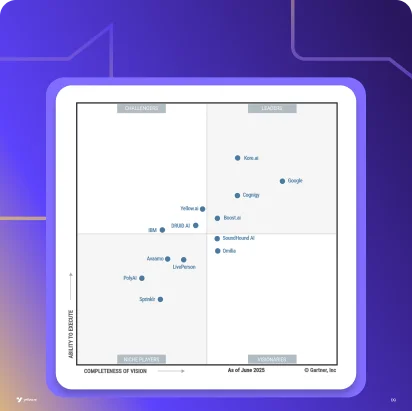Executive summary
Hop on a journey through the evolving landscape of contact center automation in 2024, where advanced technology enhances customer experience. This blog decodes the transformative trends shaping the future of contact centers, highlighting how innovations in AI, machine learning, and omnichannel communications are redefining service delivery. Explore the key contact center trends poised to drive efficiency, enhance customer interactions, and empower service teams in the coming year.
The realm of contact center automation is undergoing a seismic shift, marking 2024 as a pivotal year for technological adoption and innovation. As the backbone of customer experience, contact centers are no longer just about handling calls but are evolving into strategic customer engagement and operational efficiency hubs. Automation is a beacon of progress in this digital age, blending AI’s intelligence with the human touch to create a seamless service ecosystem.
This blog will guide you through the top automation trends in 2024, each trend not just a fleeting change but a cornerstone in building the future of contact interactions. We’ll explain how these trends streamline operations and also enhance the customer journey, offering insights into why businesses must stay ahead in this automation curve. Read on to explore a landscape where technology and human expertise converge to elevate the contact center experience beyond traditional boundaries.
Related must-reads:
- Contact center services: Types, benefits and tips for managing
- Contact center analytics: Importance and best practices
- What are the benefits of contact center AI?
- Contact center outsourcing – Benefits & challenges
What is contact center automation?
Contact center automation transforms the traditional call center into a dynamic, multi-channel hub of customer interaction and service efficiency. It leverages technology to perform routine tasks—like call routing, ticketing, and customer inquiries—without human intervention, streamlining operations and enhancing customer experiences.
At its core, contact center automation integrates tools like Interactive Voice Response (IVR), automated chatbots, and AI-driven analytics to manage and improve customer interactions across various channels. This technological infusion enables businesses to offer 24/7 support, reduce operational costs, and deliver consistent service quality. With more than half of contact centers now integrating AI to refine their service strategies, automation is becoming an indispensable asset for modern customer service operations.
Automation in contact centers is more than a trend; it’s a strategic response to evolving customer expectations. Today’s sensitized consumers engage with brands via multiple channels, expecting seamless and immediate support. Automation helps businesses meet these demands by efficiently managing high volumes of interactions, thereby enhancing customer satisfaction and loyalty. Moreover, as businesses navigate through the competitive landscape, the skill to analyze customer data and predict trends through automation becomes a game-changer, driving informed decisions and proactive service improvements.
AI is driving the future of contact center productivity.
AI is reshaping the landscape of contact center productivity, turning once futuristic ideas into today’s operational realities. With the emergence of generative AI and advanced analytics, contact centers are experiencing a seismic shift in how they interact with customers and manage workflows. Here’s why AI is not just a trend but a cornerstone in the future of contact center operations:
AI-driven efficiency and customer service enhancement
AI technology has become the backbone of modern contact centers, driving efficiencies and improving customer experiences. For instance, modern AI-powered chatbots and voice assistants are competent at handling a wide range of customer inquiries without human intervention, significantly reducing wait times and freeing up agents to tackle more complex issues. Statistics show that implementing AI can reduce call handling times by up to 40%, showcasing a direct impact on productivity and customer satisfaction.
Related must-reads:
- How to improve customer service?
- Customer service best practices to follow in 2024
- AI in customer service – Benefits and examples
- 10 Types of customer service you should know
Data-driven insights and personalization
The integration of AI in contact centers goes beyond automating routine tasks; it provides valuable data-driven insights that help businesses understand customer behaviors and preferences. AI’s ability to analyze large volumes of data in real time enables contact centers to offer personalized experiences, anticipate customer needs, and proactively address issues before they escalate. This level of personalization enhances customer loyalty and positions businesses ahead of the competition.
Evolution of AI in contact centers: A decade of innovation
Over the last decade, AI has evolved from a nascent technology to a core component of contact center operations. The journey began with basic automation tools and has now reached advanced AI solutions capable of sophisticated interactions and predictive analytics. The timeline of AI’s evolution shows rapid advancements, with significant milestones like the development of the transformer algorithm in 2017 and the launch of generative AI models such as GPT-3, which have revolutionized how businesses interact with customers.
Interested in transforming your customer service?

10 Contact center automation trends to explore in 2024
Contact center automation trends are reshaping how businesses interact with their customers, driven by advancements in technology and changing consumer expectations. Here’s a deep dive into the top 10 trends for 2024, detailing their implications, examples in practice, and actionable tips for businesses.

1. Generative AI for enhanced efficiency
Generative AI is transforming contact centers by equipping them with advanced AI capabilities that go beyond scripted responses. These AI systems generate real-time, contextually aware interactions, tailoring conversations to match customer mood and query complexity. This technology enables virtual agents to understand and respond to queries with nuance and accuracy previously attainable only by highly skilled human agents.
Generative AI significantly enhances operational efficiency by automating complex customer interactions, leading to faster resolution times and higher customer satisfaction. It decreases the workload on human agents, permitting them to handle more complex and sensitive issues that require human empathy and judgment.
Example:
Consider a contact center using generative AI to handle customer inquiries about billing discrepancies. The AI can analyze the customer’s account history, identify the source of the discrepancy, and provide a clear, accurate explanation to the customer, all in real time. Besides speeding up the resolution process, it also ensures that the information provided is consistent and accurate.
What businesses should do:
- Evaluate current processes: Assess how generative AI can integrate into existing workflows to enhance efficiency.
- Implement pilot projects: Start with pilot projects in high-impact areas to measure the effectiveness of generative AI in reducing response times and improving customer satisfaction.
- Train staff: Prepare your team to work alongside AI systems, focusing on handling escalated issues and using AI-generated insights to improve service quality.
2. Omnichannel support expansion
Omnichannel support refers to providing a seamless customer experience across several communication channels, including phone, email, chat, and social media. In 2024, the trend is towards not just multi-channel availability but a truly integrated experience where all channels are interconnected, allowing customers to switch between them without losing context or repeating information.
This approach significantly improves customer satisfaction by providing a consistent and fluid experience, regardless of the chosen communication channel. It also increases operational efficiency by enabling agents to gain a holistic view of the customer’s journey and issues, leading to faster and more effective resolutions.
Example:
A customer begins a service inquiry via live chat but needs to leave their computer and continue the conversation on their mobile phone. With omnichannel support, the transition is seamless; the conversation history is available to the agent handling the phone call, allowing them to continue where the chat left off without any loss of information.
What businesses should do:
- Invest in integrated platforms: Implement solutions that unify customer interactions across all channels into a single, accessible interface for agents.
- Focus on data continuity: Ensure that customer data flows seamlessly between channels to maintain context and history in every interaction.
- Train for cross-channel proficiency: Prepare your team to handle customer interactions fluidly across different channels, emphasizing the importance of maintaining conversation continuity.
3. Hyper-personalization
Hyper-personalization in contact centers means leveraging data and analytics to provide tailored experiences to each customer. It involves understanding customer preferences, behaviors, and history to offer customized solutions and interactions. AI and machine learning play crucial roles in analyzing vast amounts of data to predict customer needs and personalize their experience.
Hyper-personalization enhances customer satisfaction by making interactions more relevant and meaningful. It increases engagement and loyalty, as customers feel valued and understood. Additionally, it can lead to more efficient problem resolution and increased sales opportunities by targeting offers and solutions that align with individual customer profiles.
Example:
A customer contacts a service center about a recurring issue. With hyper-personalization, the system recognizes the customer and their history, immediately providing the agent with a comprehensive view of past interactions, preferences, and potential solutions, allowing for a quick and personalized response.
Related read: Contact Center as a Service (CCaaS) – Features and benefits
What businesses should do:
- Leverage customer data: Utilize CRM and analytics tools to gather and analyze customer data, creating detailed customer profiles.
- Implement AI-driven solutions: Use AI to automate the analysis and application of customer data in real time, ensuring personalized interactions.
- Train staff on personalization techniques: Educate customer service representatives on using customer data to tailor interactions and offer personalized solutions.
4. Evolving IVR systems
Interactive Voice Response (IVR) systems are evolving from simple menu-driven interfaces to advanced, AI-powered conversational agents. Modern IVR systems can understand natural language, respond to complex queries, and provide personalized customer support without human intervention.
The evolution of IVR systems enhances customer self-service options, reducing wait times and freeing up human agents for more complex inquiries. Advanced IVR systems can improve customer satisfaction by quickly directing them to the information or service they need using an intuitive, conversational interface.
Example:
A customer calls their telecom provider to inquire about an unexpected charge on their bill. Instead of navigating through a series of numerical options, the customer simply asks the question, and the AI-powered IVR system understands the query and provides an immediate explanation or escalates the call to a specialized agent if necessary.
What businesses should do:
- Invest in advanced IVR technology: Implement IVR systems that support natural language processing and machine learning for better customer understanding.
- Integrate IVR with omnichannel platforms: Ensure the IVR system is integrated with other communication channels for a seamless customer experience.
- Monitor and optimize IVR performance: Regularly analyze IVR interactions to identify opportunities for improvement and ensure the system effectively meets customer needs.
5. Predictive analytics for proactive issue resolution
Predictive analytics in contact centers involves using data, statistical algorithms, and machine learning techniques to identify the likelihood of future outcomes based on historical data. It’s about anticipating customer issues before they escalate and proactively addressing them, thereby enhancing customer satisfaction and loyalty.
Utilizing predictive analytics can significantly improve the efficiency of a contact center by reducing call volumes and increasing first-contact resolution rates. It facilitates businesses to offer a more customized and anticipatory customer service experience, increasing customer retention and trust.
Related read: 10 Great customer service experience examples in 2024
Example:
A retail company uses predictive analytics to monitor buying patterns and customer inquiries. By analyzing this data, they proactively reach out to customers who are likely to have issues with a product during peak complaint times, offering solutions or support before the customer initiates contact.
What businesses should do:
- Invest in data analytics tools: Utilize advanced analytics solutions that can process large volumes of data to identify trends and patterns.
- Train teams on data insights: Ensure customer service teams understand how to use predictive insights to address potential customer issues proactively.
- Integrate across channels: Use predictive analytics across all customer interaction channels to ensure a cohesive and proactive approach to customer service.
6. Self-service tools
Self-service tools empower customers to find solutions to their problems without needing to contact a customer service representative. These tools include FAQs, interactive guides, knowledge bases, and automated chatbots that provide immediate assistance.
Related read: 17 Best knowledge base software (2024)
Self-service technologies may greatly alleviate the burden on contact centers, allowing agents to focus on more intricate inquiries. This tool also meets the customer’s preference for quick and accessible solutions, enhancing their overall experience and satisfaction with the service.
Example:
A software company implements a self-service portal that includes tutorials, video guides, and a searchable knowledge base. Customers can troubleshoot common issues independently, decreasing support tickets and increasing customer self-reliance and satisfaction.
What businesses should do:
- Develop comprehensive knowledge bases: Create and maintain detailed and easily accessible knowledge bases that customers can use to solve their issues.
- Utilize AI-powered chatbots: Implement intelligent chatbots that can understand and resolve common customer queries, guiding users to appropriate self-service resources.
- Monitor and update resources regularly: Continually assess and update self-service tools to ensure they meet customer needs and reflect current products and services.
7. Virtual assistants and voice commands
Virtual assistants and voice command technology in contact centers use AI to understand and respond to customer inquiries through spoken language. These tools can automate routine tasks, provide information, and assist with customer service inquiries through natural, conversational interactions.
Integrating virtual assistants and voice commands can enhance the customer experience by providing quick, efficient, and hands-free support. It can also streamline operations and reduce the dependency on live agents for routine inquiries, thereby optimizing resource allocation.
Example:
A telecommunications company integrates a virtual assistant into their contact center, enabling customers to check account balances, make payments, and report issues using voice commands. It leads to faster resolutions, higher customer satisfaction, and reduced call volumes for live agents.
What businesses should do:
- Implement advanced voice recognition: Invest in technology that can accurately understand and process natural language queries.
- Integrate with existing systems: Ensure that voice command tools are fully integrated with other contact center systems for seamless customer support.
- Train and adapt: Continually train the AI models on new queries and commands to improve understanding and accuracy, adapting to customer feedback and evolving needs.
8. Robust security measures
In the digital age, contact centers must prioritize security to protect sensitive customer information and comply with data protection regulations. Robust security measures in contact centers include encryption, access controls, regular security audits, and integration of advanced cybersecurity technologies.
Implementing stringent security protocols protects against data breaches and cyber threats and builds customer trust. Customers are more likely to engage with a brand they believe is secure and responsible with their data.
Example:
A leading insurance firm upgraded its contact center’s defenses in response to growing cyber threats. They introduced multi-factor authentication for every customer call and chat, secured data transfers with end-to-end encryption, and initiated a continuous education program on cybersecurity for their team. These measures led to a marked decrease in security breaches and significantly bolstered trust among their clientele.
What businesses should do:
- Regular training and awareness: Conduct ongoing cybersecurity training for all contact center employees to recognize and respond to potential threats.
- Invest in advanced security solutions: Utilize cutting-edge security technology, such as AI-driven threat detection systems, to identify and neutralize threats proactively.
- Continuous monitoring and compliance: Implement monitoring tools to detect unusual activities and ensure compliance with industry-specific security standards and regulations.
9. Automated routing
Automated routing in contact centers uses AI and machine learning algorithms to analyze incoming communications. It aims to direct them to the most appropriate agent or department based on the customer’s needs, history, and the issue’s complexity. Experts at Gartner say that by 2026, the percentage of automated contacts with agents will have grown five times and be around 10%.
This trend improves operational efficiency by reducing wait times and ensuring customers are connected with the right expertise, leading to faster resolutions and enhanced customer satisfaction.
Example:
A healthcare provider employs automated routing in its contact center to immediately connect patients with the correct department, whether it’s billing, appointments, or medical advice, based on the urgency and nature of their call. This results in more efficient service and better patient care.
What businesses should do:
- Integrate customer data: Utilize comprehensive customer data to inform the routing algorithms, ensuring a more personalized and effective routing process.
- Monitor and optimize: It’s crucial to review the performance of your routing system regularly. This ongoing process allows you to identify areas for improvement and optimize the algorithms, ensuring your business operates at its most efficient
- Balance automation and human touch: While automating the routing process, ensure there are mechanisms for customers to easily reach a human agent when needed, maintaining the balance between efficiency and personalization.
10. Agent well-being and empowerment
Prioritizing agent well-being by fostering an environment conducive to mental wellness, job fulfillment, and career growth goes a long way. It’s about equipping agents with the tools, training, and decision-making authority they need to address customer issues competently and confidently.
Investing in agent well-being and empowerment leads to higher job satisfaction, reduced turnover, and improved performance. It results in better customer service and increased customer loyalty.
Related read: AI Agents: Types, Benefits and Examples
Example:
A technology company implements regular well-being workshops, flexible working conditions, and a clear path for career advancement. It also empowers its agents by giving them access to comprehensive customer data and the authority to make certain decisions independently. As a result, the company sees improved agent satisfaction, reduced turnover, and positive feedback from customers regarding the quality of service.
What businesses should do:
- Promote a healthy work environment: Implement initiatives that support mental health and work-life balance, such as flexible working hours and wellness programs.
- Provide continuous training and development: Offer ongoing training opportunities to help agents enhance their skills and keep upgrading to flourish in their careers.
- Equip with the right tools: Ensure agents have access to the latest technology and comprehensive customer insights to efficiently and effectively resolve customer inquiries.
Success stories

Hyundai boosts revenue and improves customer service with AI automation
Explore how Yellow.ai’s automation led to ~1000 car sales, a 10% retail conversion rate, and over 1.4 million user impressions

Pelago reimagines customer experience with generative AI powered conversational AI agents
Within a mere six weeks of going live, Pelago not only onboarded over 5,000 users but also achieved a striking 50% deflection rate!
Conclusion: Contact center automation is the future
The landscape of contact centers is set for a transformative journey, where automation becomes not just a tool but a strategic ally in redefining customer experiences. The horizon of contact center automation is vast, promising a future where technology and human ingenuity merge to create unparalleled service dynamics. It’s a realm where every interaction is an opportunity to impress, resolve, and retain, propelled by the sophisticated engines of AI and data analytics.
In this evolving narrative, Yellow.ai emerges as a pivotal partner for businesses seeking to harness the power of these trends. With its advanced AI-driven solutions, Yellow.ai is poised to help companies navigate the complexities of automation, ensuring they remain at the forefront of innovation and service excellence. As we embrace these trends, the journey ahead is promising, filled with opportunities to redefine connections and craft memorable customer experiences that stand the test of time.






















